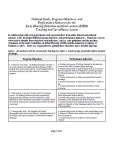Early Hearing Detection and Intervention (EHDI) National Goals
Vision, Mission, Goals, Program Objectives and Performance Indicators
The vision of the Center for Disease Control and Prevention’s (CDC) Early Hearing Detection and Intervention (EHDI) program is to promote communication from birth for all children.
Our Mission
The mission of CDC EHDI programs is for every state and territory to have a complete EHDI tracking and surveillance system that ensures children with hearing loss achieve communication and social skills commensurate with their cognitive abilities. To do this, it is essential that infants with hearing loss are identified early, and appropriate intervention services are initiated. Without early identification and intervention, children with hearing loss may experience delays in the development of language, cognitive, and social skills that may prevent success in academic and occupational achievement.
Our Goals
CDC and state representatives developed seven national goals that illustrate the comprehensiveness of EHDI programs, and reflect the ideal achievement. For each national goal there is a set of specific program objectives, that are essential in accomplishing each national goal. Each program objective has a quantitative measure(performance indicator) that can be used to track the progress toward the goals and objectives (Click on Goals 1-7 below for objectives and indicators).
The first three goals reflect the recommendations of other organizations, such as NIH/NIDCD, HRSA/MCHB, JCIH, ASHA, AAA, and AAP(see explanation of acronyms).
These first three goals are frequently referred to as the 1-3-6 plan.
Comprehensive EHDI tracking and surveillance systems must go beyond the 1-3-6 plan. There is a need for the EHDI system to identify and track infants and young children who are missed or who do not have an identified hearing loss at birth. Primary Care Providers (PCPs), parents, and other care providers should refer an infant for screening any time they suspect a hearing loss. Audiologists who later identify infants and children with a hearing loss should report it to the EHDI tracking system.
Goal 5: All infants with hearing loss will have a medical home.
PCPs play a key role in the success of the EHDI programs. It is critical that infants and their families have a medical home and that services are coordinated between the medical home and the EHDI program. PCPs can help families understand the EHDI process and ensure that infants referred for audiologic evaluation complete that evaluation by 3 months of age.
The EHDI tracking system should include all infants who are identified with a hearing loss, including infants with a mild or unilateral loss. The system should also include infants who have risk factors for late onset or progressive hearing loss and infants and children identified beyond the newborn period with a hearing loss. All identified infants should be referred to intervention services. These services include medical, educational, audiologic, and support services. These services must be coordinated between the family, the medical home, early intervention services, audiologists, and other professionals involved in the care of infants and children with hearing loss.
It is important for the EHDI state programs to evaluate how their program is being implemented and the extent to which the objectives are being achieved. Families and other stakeholders should be involved in the evaluation process. Evaluation should be an on-going process. Written reports on the progress and status of the state need to be regularly produced.
The EHDI tracking system is designed to minimize the loss to follow-up and ensure that all infants with hearing loss receive intervention services that will allow them to achieve their optimal level of communication and social skills. This document provides guidance on setting-up stated-based EHDI programs to fulfill our mission.
Contact Us:
- Centers for Disease Control and Prevention
National Center on Birth Defects and Developmental Disabilities
Hearing Loss Team
1600 Clifton Road
MS E-87
Atlanta, GA 30333 - 800-CDC-INFO
(800-232-4636)
TTY: (888) 232-6348
New Hours of Operation
8am-8pm ET/Monday-Friday
Closed Holidays - cdcinfo@cdc.gov



